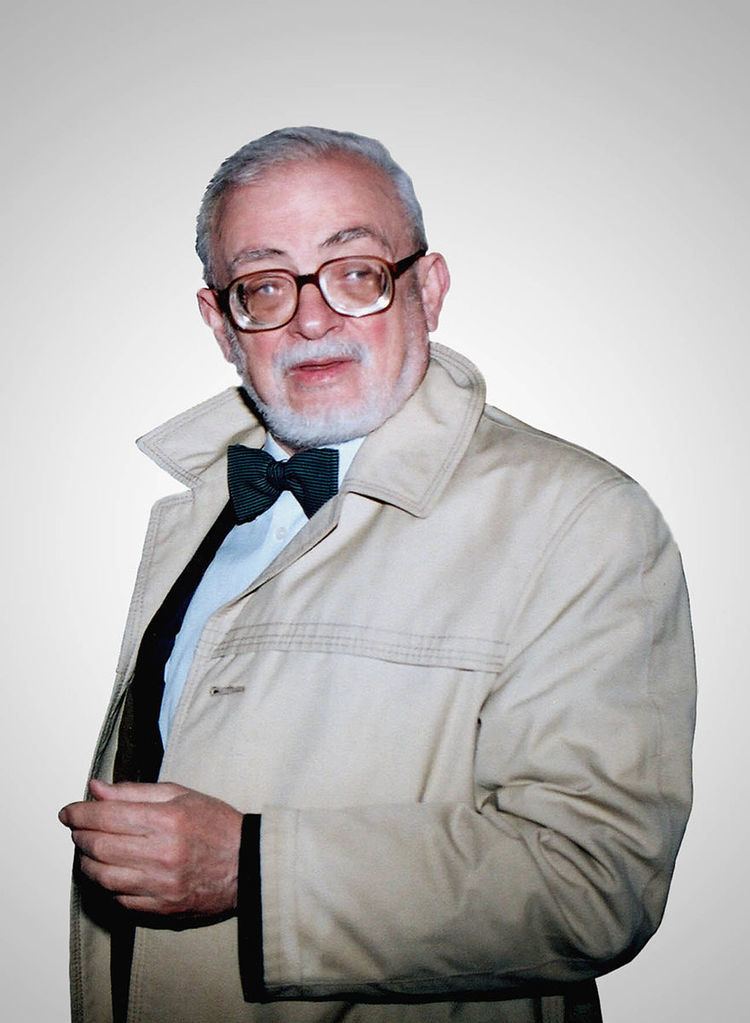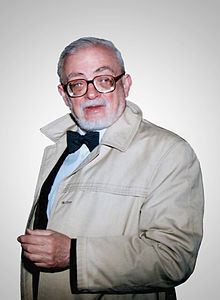Nationality Serbian Name Mihailo Canak | Occupation Architect | |
 | ||
Died 1 December 2014(2014-12-01)Belgrade, Serbia Buildings Block 21 (Novi Beograd), Liman I and II (Novi Sad), Kreativni centar (Belgrade), etc. | ||
Pri a o babi sa kr a arh mihailo anak ika mika
Mihailo Čanak (Serbian Cyrillic: Михаило Чанак) was a Serbian architect and researcher. He was born in Belgrade, on 2 June 1932. He is a founder and a board member of Center for Housing CS with Djordje Alfirevic in Belgrade (Centar za stanovanje CS). He holds a PhD degree from the University of Belgrade Faculty of Architecture.
Contents
- Pri a o babi sa kr a arh mihailo anak ika mika
- Otvoreni i zatvoreni stan arh mihailo anak part 1 2
- Biography
- Architectural design
- Public competitions and competitions on invitation selection
- Designs and constructions
- Research work
- Quality and value in use of apartments and apartment buildings
- The influence of structural systems on the value in use of apartments and apartment buildings
- Quantitative evaluation of quality of living and housing construction
- References
Otvoreni i zatvoreni stan arh mihailo anak part 1 2
Biography

Born on June 2, 1932, in Belgrade. Father Stevan (1899), mother Olga Dinić(1906). Graduated primary school and high school in Belgrade. Enrolled in the Faculty of Architecture in Belgrade in 1951, graduated in June, 1957, with average note 9.45. Got master’s degree in 1975, at the 5th graduate course “Town Planning” at the Faculty of Architecture in Belgrade, with the thesis “Functional Aspects of the Organization of Apartments and their Influence on the Formation of Apartment Structures”, got PhD degree in 1984, at the same faculty, with the thesis “Evaluation of Quality of Housing Construction and of Life in Apartments”. Got the title of Senior Scientific Fellow in 1985, and of Scientific Advisor in 1993. Passed the State Examination in 1962. Graduated the specialized course “Prefabricated Building Construction” in Paris, in 1967. Married with Dr. Nada Čanak (Djuričin), ecologist (1935).. Son: Miloš, architect (1966).
Employed in 1957 in the Institute for Testing Materials of Serbia, where he was Director of the Center for Housing during the period 1970-1986. In 1986, joined the Institute for Architecture and Town Planning of Serbia, Director of that Institute until 1988. Stayed in the Institute as Scientific Advisor until retirement in 1999. During the time period 1968-1987 permanent member of the Yugoslav delegation in the Group for Building EEC UN in Geneva. His proposal for the international research project “Quality Evaluation in Housing” was adopted and implemented during the period 1982-1987. Presented reports at a number of Yugoslav and international congresses and workshops. Speaks French.
Since 1991 he opened, in Belgrade, together with his son Milos Canak, the Bureau for Architectural Design Research and Education “ARD” (Architectural Research and Design).
Architectural design
During his design career, Čanak went through four basic stages, namely:
During the study, in 1953, Michael Čanak with four other colleagues and friends (L.Lenarčić, M.Mitić, I.Petrović and I.Simović), founded the group "Belgrade 5". Many awards and more realizations (two apartment buildings in Block 21 in Novi Beograd, Liman I and II in Novi Sad, etc.) marked the work of this group. This is also a first phase in the designing work of Michael Čanak, during which he will prove a vigorous supporter of functional minimalism, characteristic for the so-called, Industrial Modernism. This development phase, positioned between the Early Modernism, International style, and Late Modernism, without including the Postmodern experimentation, lasted up to 1970. (Blocks 29, 45 and 70 in New Belgrade, etc.). In the same period, along with planning activities, Čanak deals with scientific research in the field of housing quality.
The second phase in his designing opus is tied to the collaboration with architect Alexandar Djokić "with whom he thought in a similar manner, although their approaches were very different." This phase begins 1970th years, after winning 1st prizes at the competition for housing development Kijevo-Kneževac (implementation year 1971-80.). Since then Čanak soothes his minimalism and turned to „Articulated late Modern“ (settlement "Košutnjak" in Belgrade). In 1982, with P.Napijalo and D.Simić realized some housing group in the settlement "Bežanijska kosa" in Belgrade. In the same period Čanak become a master's degree (1975), he received his doctorate (1984), and received the title: Senior research associate. Since 1983 god. he organized and led "Preparatory course for the study of architecture", where pedagogical work (in addition to the design and scientific-research any) gets a special place in the list of his professional activities. In the framework of scientific research, Čanak is actively involved in the issue of evaluating the quality of housing and residential construction, In the period 1970-87 he participated in the Working Group on Construction CEE UN as a member of the Yugoslav delegation. He suggested the international project "Evaluating the quality of housing", which was accepted and implemented.
The third phase of Čanak’s design work began in 1986. (When coming on the post of Director IAUS) and lasts until 1990. This is the period of his experimentation with so-called. Urban vernacular architecture (3 housing buildings in Loznica, Office building in Kraljevo, a green market in Banja Koviljača, the interior shops "Košuta" in Belgrade).
In 1991, Čanak with his son Miloš opened a private office "ARD" (Architectural Research & Design) and it is the beginning of the fourth phase in his designing opus. During that period Čanak returned to Neomodernism with some elements of Expressionism and Deconstruction (the building project "Creative Center" in Belgrade). In 1993 he received the title of Scientific Adviser. After son's going abroad, Michael Čanak in their activities giving priority to pedagogical work. Laminated theoretical and practical knowledge, but also his exceptional pedagogical abilities have contributed to "ARD" exchange gain reputation not only among young people who have been directed to study architecture, but also to larger circles of professionals.
Public competitions and competitions on invitation (selection)
Designs and constructions
Research work
While working at the Institute for Material Testing of Serbia, Čanak noted that many, then valid, principles in the design of dwellings are not sufficiently scientifically based, so that Čanak a part of its activities focused on scientific research in the field of habitology. In addition to several partial studies, his work is mainly focused ussines in three directions:
Quality and value in use of apartments and apartment buildings
Over 40 studies, articles in scientific magazines and reports at congresses and workshops, the most important being the group of studies devoted to the functional aspects of structures, equipment, organization, dimension parameters and concepts of apartments and apartment buildings. The synthesis of those articles is given in the study “Functional concept and value in use of apartments” IMS, (1976). Participated as a member of the working team in the research of living conditions in the New Belgrade apartment blocs 21, 22 and 29, at the biggest sample in our country “Social Structure of a Housing Settlement” (group of authors), IMS (1978). As a member of bigger teams, participated in the elaboration of the standards for the design of apartments in Belgrade, and of individual apartment houses. Coordinator of the Yugoslav team for elaboration of the monograph “South-south cooperation in the field of housing and housing construction” IAUS (1986).
The influence of structural systems on the value in use of apartments and apartment buildings
Over 15 studies and articles in professional magazines devoted to the improvement of the values in use of apartments and apartment buildings in the systems IMS, Jingrap, Ecodomus and Ivanjica (autonomously or as member of working teams). “Functional and architectural aspects of the prefabricated skeleton system IMS”, IMS, 1968, “A study of functional and form possibilities of the Ecodomus system” ARD, 1991 (with M. Čanak), etc. A number of works devoted to the determination of the value in use of various spans in the skeletons and of systems with bearing walls. “A comparative analysis of the functional possibilities of skeleton systems and of systems with transversal bearing walls”,IMS, 1978. “Big spans between transversal walls in housing construction” IMS, 1981. “Determination of the value in use of structural systems”, IMS, 1983, etc. A study of the influence of the standardization on the quality of the functional and form concepts of apartment buildings. An analysis of the economic consequences of designers’ decisions.
Quantitative evaluation of quality of living and housing construction
Over 20 studies, articles in professional magazines, and reports at congresses and workshops devoted to the theory and practice of quantitative evaluation of the quality and of the value in use of apartments and of housing construction. The theoretical aspects of that problem are explained in the PhD thesis “The evaluation of quality of living and of housing construction” (1983), and in a number of other works; the practical verification of the results of the research was performed in a number of concrete evaluation procedures of the so-called “models”, aimed at the evaluation of apartments, of apartment buildings, of building sites for housing construction, of garbage landfills, of building materials, structural systems, spans, etc. The common principles for the elaboration of these models are defined in the synthetic document “The universal System for evaluation in the field of housing, building and planning YU.88” IAUS 1988. The elaboration of the national monograph “Evaluation in the field of housing, building and planning” IAUS, 1988, which was presented at the international workshop on the evaluation of quality of apartments in Copenhagen in 1988, organized by the Committee for building, housing and planning of the CEE, UN.
